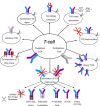How (specific) would like your T-cells today? Generating T-cell therapeutic function through TCR-gene transfer
- PMID: 22783259
- PMCID: PMC3390604
- DOI: 10.3389/fimmu.2012.00186
How (specific) would like your T-cells today? Generating T-cell therapeutic function through TCR-gene transfer
Abstract
T-cells are central players in the immune response against both pathogens and cancer. Their specificity is solely dictated by the T-cell receptor (TCR) they clonally express. As such, the genetic modification of T lymphocytes using pathogen- or cancer-specific TCRs represents an appealing strategy to generate a desired immune response from peripheral blood lymphocytes. Moreover, notable objective clinical responses were observed in terminally ill cancer patients treated with TCR-gene modified cells in several clinical trials conducted recently. Nevertheless, several key aspects of this approach are the object of intensive research aimed at improving the reliability and efficacy of this strategy. Herein, we will survey recent studies in the field of TCR-gene transfer dealing with the improvement of this approach and its application for the treatment of malignant, autoimmune, and infectious diseases.
Keywords: T-cell receptor; T-cells; TCR-gene transfer; autoimmunity; cancer; immunotherapy; infectious diseases.
Figures
Similar articles
-
Genetic engineering of T cell specificity for immunotherapy of cancer.Hum Immunol. 2003 Jan;64(1):56-68. doi: 10.1016/s0198-8859(02)00730-9. Hum Immunol. 2003. PMID: 12507815 Review.
-
Immunotherapy through TCR gene transfer.Nat Immunol. 2001 Oct;2(10):957-61. doi: 10.1038/ni1001-957. Nat Immunol. 2001. PMID: 11577349
-
Human effector T cells derived from central memory cells rather than CD8(+)T cells modified by tumor-specific TCR gene transfer possess superior traits for adoptive immunotherapy.Cancer Lett. 2013 Oct 10;339(2):195-207. doi: 10.1016/j.canlet.2013.06.009. Epub 2013 Jun 18. Cancer Lett. 2013. PMID: 23791878
-
Hepatitis E Virus (HEV)-Specific T Cell Receptor Cross-Recognition: Implications for Immunotherapy.Front Immunol. 2019 Sep 4;10:2076. doi: 10.3389/fimmu.2019.02076. eCollection 2019. Front Immunol. 2019. PMID: 31552033 Free PMC article.
-
Redirecting T lymphocyte specificity by T cell receptor gene transfer--a new era for immunotherapy.Mol Aspects Med. 2007 Feb;28(1):115-42. doi: 10.1016/j.mam.2006.12.006. Epub 2007 Jan 11. Mol Aspects Med. 2007. PMID: 17307249 Review.
Cited by
-
A TCR-based Chimeric Antigen Receptor.Sci Rep. 2017 Sep 6;7(1):10713. doi: 10.1038/s41598-017-11126-y. Sci Rep. 2017. PMID: 28878363 Free PMC article.
-
Targeting TGFβ with chimeric switch receptor and secreted trap to improve T cells anti-tumor activity.Front Immunol. 2024 Oct 24;15:1460266. doi: 10.3389/fimmu.2024.1460266. eCollection 2024. Front Immunol. 2024. PMID: 39512355 Free PMC article.
-
TCRγ4δ1-engineered αβT cells exhibit effective antitumor activity.Mol Med. 2016 Oct;22:519-529. doi: 10.2119/molmed.2016.00023. Epub 2016 Jul 26. Mol Med. 2016. PMID: 27463149 Free PMC article.
-
Molecular insights for optimizing T cell receptor specificity against cancer.Front Immunol. 2013 Jun 19;4:154. doi: 10.3389/fimmu.2013.00154. eCollection 2013. Front Immunol. 2013. PMID: 23801991 Free PMC article.
-
Targeting Multiple Tumors Using T-Cells Engineered to Express a Natural Cytotoxicity Receptor 2-Based Chimeric Receptor.Front Immunol. 2017 Sep 29;8:1212. doi: 10.3389/fimmu.2017.01212. eCollection 2017. Front Immunol. 2017. PMID: 29085357 Free PMC article.
References
-
- Aarnoudse C. A., Kruse M., Konopitzky R., Brouwenstijn N., Schrier P. I. (2002). TCR reconstitution in Jurkat reporter cells facilitates the identification of novel tumor antigens by cDNA expression cloning. Int. J. Cancer 99 7–13 - PubMed
-
- Ahmadi M., King J. W., Xue S. A., Voisine C., Holler A., Wright G. P., Waxman J., Morris E., Stauss H. J. (2011). CD3 limits the efficacy of TCR gene therapy in vivo. Blood 118 3528–3537 - PubMed
-
- Alajez N. M., Schmielau J., Alter M. D., Cascio M., Finn O. J. (2005). Therapeutic potential of a tumor-specific, MHC-unrestricted T-cell receptor expressed on effector cells of the innate and the adaptive immune system through bone marrow transduction and immune reconstitution. Blood 105 4583–4589 - PMC - PubMed
LinkOut - more resources
Full Text Sources
Other Literature Sources
Research Materials


